 Flowering maples are a group of tender, evergreen perennials often used as seasonal annuals or houseplants in the Midwest. Sometimes also collectively referred to as Chinese bellflower or Chinese lantern – or just abutilon, flowering maples were popular during the Victorian era, later fell out of favor in the gardening world, but have returned to modern gardens in a plethora of forms.
Flowering maples are a group of tender, evergreen perennials often used as seasonal annuals or houseplants in the Midwest. Sometimes also collectively referred to as Chinese bellflower or Chinese lantern – or just abutilon, flowering maples were popular during the Victorian era, later fell out of favor in the gardening world, but have returned to modern gardens in a plethora of forms. 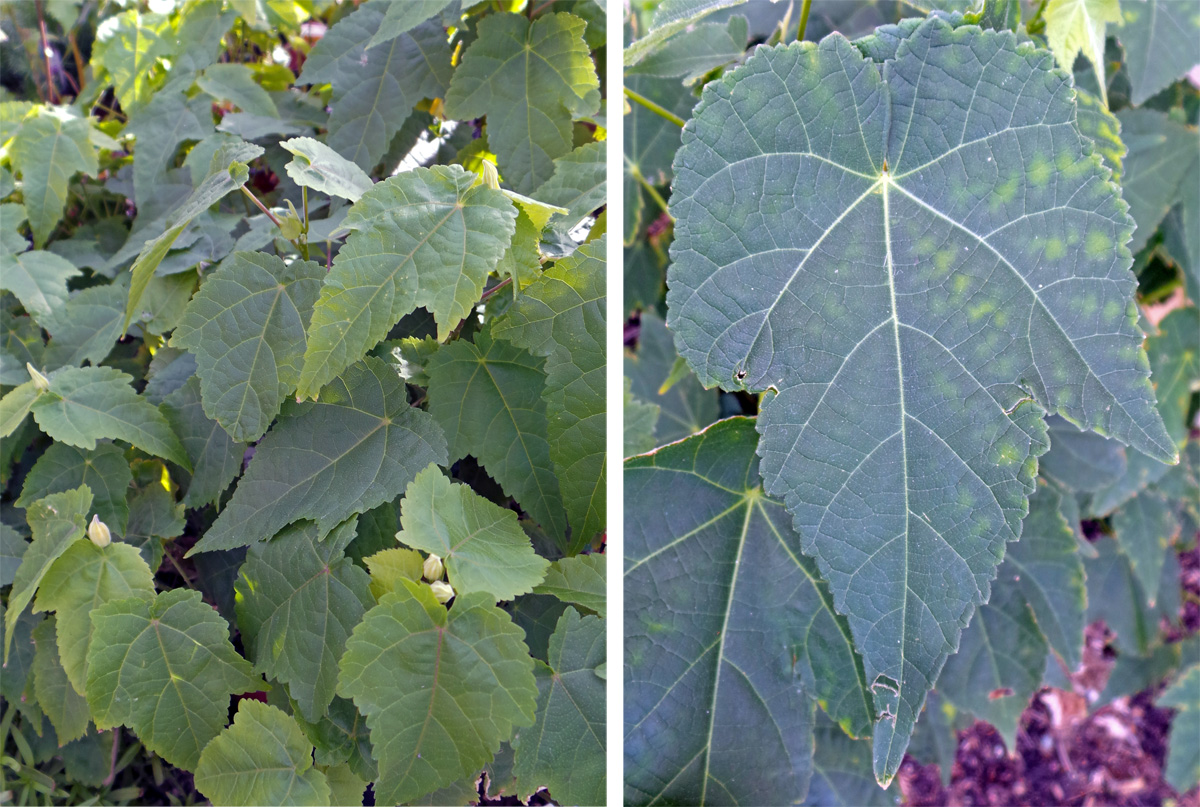 The genus Abutilon is a large group of flowering plants in the mallow family (Malvaceae) with over 200 species occurring throughout the tropics and subtropics. They range in height from 18 inches to 10 feet, and may be herbaceous perennials, shrubs, or small trees. The plants used as ornamentals are often A. x hybridum, a group of hybrids between A. darwinii and A. striatum, or cultivars of other species, such as A. megapotamicum and A. pictum. These plants get part of their common name from the resemblance of the foliage to maple leaves. The plants are unrelated to maples (Acer spp.) but do have palmate leaves often with deep, pointed lobes and/or serrated edges. The leaves may cause mild dermatitis in susceptible individuals.
The genus Abutilon is a large group of flowering plants in the mallow family (Malvaceae) with over 200 species occurring throughout the tropics and subtropics. They range in height from 18 inches to 10 feet, and may be herbaceous perennials, shrubs, or small trees. The plants used as ornamentals are often A. x hybridum, a group of hybrids between A. darwinii and A. striatum, or cultivars of other species, such as A. megapotamicum and A. pictum. These plants get part of their common name from the resemblance of the foliage to maple leaves. The plants are unrelated to maples (Acer spp.) but do have palmate leaves often with deep, pointed lobes and/or serrated edges. The leaves may cause mild dermatitis in susceptible individuals. 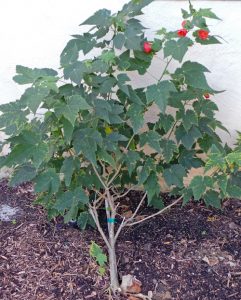 They are upright, branching plants—often with brittle stems—and some varieties have a structure reminiscent of a Japanese maple. They are low growing woody subshrubs that acts as herbaceous perennials in colder climates, supposedly hardy only in zones 9-11, but will survive in some colder areas as long as the plants have excellent soil drainage. The generally solitary pendent flowers are borne on long pedicels from leaf axils or near the branch tips on the current season’s growth. The lantern-like buds open to cup- or bell-shaped flowers up to 3 inches in diameter.
They are upright, branching plants—often with brittle stems—and some varieties have a structure reminiscent of a Japanese maple. They are low growing woody subshrubs that acts as herbaceous perennials in colder climates, supposedly hardy only in zones 9-11, but will survive in some colder areas as long as the plants have excellent soil drainage. The generally solitary pendent flowers are borne on long pedicels from leaf axils or near the branch tips on the current season’s growth. The lantern-like buds open to cup- or bell-shaped flowers up to 3 inches in diameter.  All have a calyx and corolla with 5 parts, with overlapping papery petals fused at the base, opening to various degrees from trumpet shaped to nearly flat. The flowers have staminal columns typical of the mallow family, with multiple stamens fused into a column lined with anthers, and a branched style with head-like stigmas inside the tube (very similar to that of its relative the hibiscus). The species generally have yellow or orange flowers, but others have red or pink petals with a darker center.
All have a calyx and corolla with 5 parts, with overlapping papery petals fused at the base, opening to various degrees from trumpet shaped to nearly flat. The flowers have staminal columns typical of the mallow family, with multiple stamens fused into a column lined with anthers, and a branched style with head-like stigmas inside the tube (very similar to that of its relative the hibiscus). The species generally have yellow or orange flowers, but others have red or pink petals with a darker center. 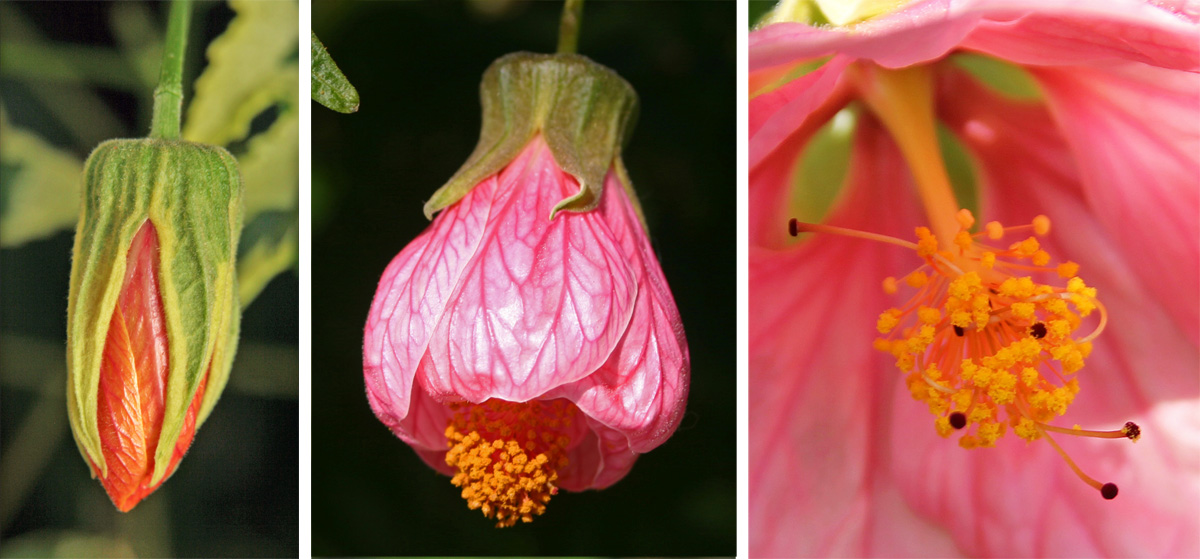 Many are attractive to butterflies and hummingbirds. Hybrids rarely set fruit, but the species produce hemispherical pods (schizocarps) with multiple segments, each containing a few seeds.
Many are attractive to butterflies and hummingbirds. Hybrids rarely set fruit, but the species produce hemispherical pods (schizocarps) with multiple segments, each containing a few seeds. 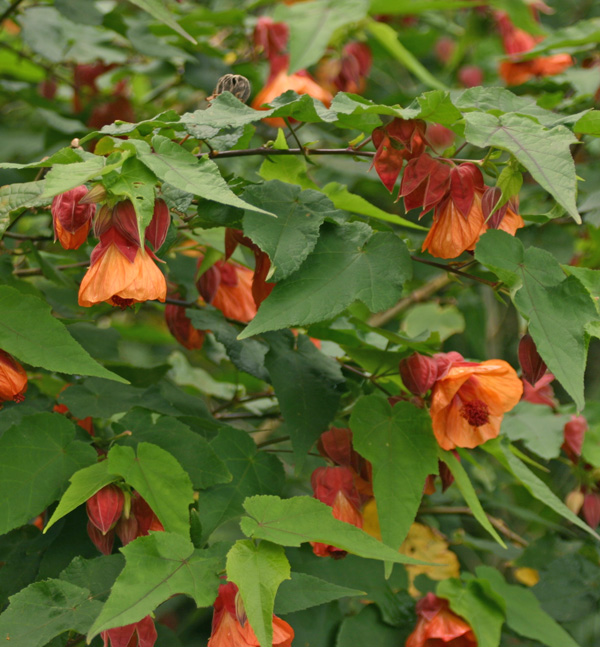 The species tend to bloom most prolifically in summer and fall, but modern hybrids have been developed to bloom nearly year-round. Flower color has been expanded by breeders as well, with flower colors ranging from white to reds, yellow, orange, coral and bicolors.
The species tend to bloom most prolifically in summer and fall, but modern hybrids have been developed to bloom nearly year-round. Flower color has been expanded by breeders as well, with flower colors ranging from white to reds, yellow, orange, coral and bicolors. 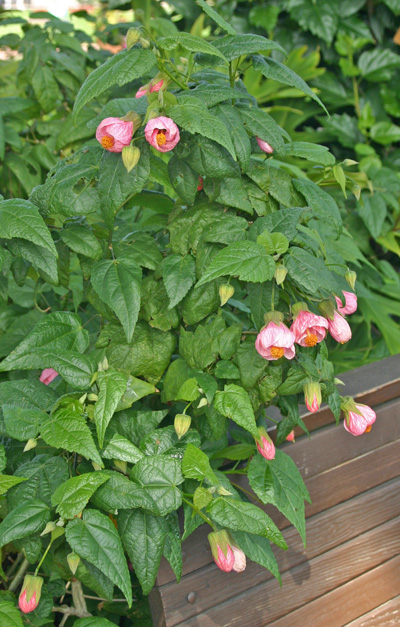 Flowering maples are a great addition to annual or mixed beds or borders, The can be used alone or with other plants in containers, such as patio pots or window boxes. They work well in hanging baskets, where it is easier to see the downward facing flowers. Flowering maple can be grown as a multi-stemmed shrub or pruned as a standard for a more tree-like effect, and many types can even be used for espalier. The variegated forms may be grown more as foliage plants than for their flowers. Grow flowering maple in full sun or partial shade. They grow in almost any type of soil as long as it is well-drained and evenly moist, doing best in rich soils. Plants will struggle if allowed to dry out too much. They typically do not have any significant insect or disease problems outdoors, but indoor plants are susceptible to the most common insect pests including aphids, mealybugs, scales and whiteflies, as well as spider mites.
Flowering maples are a great addition to annual or mixed beds or borders, The can be used alone or with other plants in containers, such as patio pots or window boxes. They work well in hanging baskets, where it is easier to see the downward facing flowers. Flowering maple can be grown as a multi-stemmed shrub or pruned as a standard for a more tree-like effect, and many types can even be used for espalier. The variegated forms may be grown more as foliage plants than for their flowers. Grow flowering maple in full sun or partial shade. They grow in almost any type of soil as long as it is well-drained and evenly moist, doing best in rich soils. Plants will struggle if allowed to dry out too much. They typically do not have any significant insect or disease problems outdoors, but indoor plants are susceptible to the most common insect pests including aphids, mealybugs, scales and whiteflies, as well as spider mites. 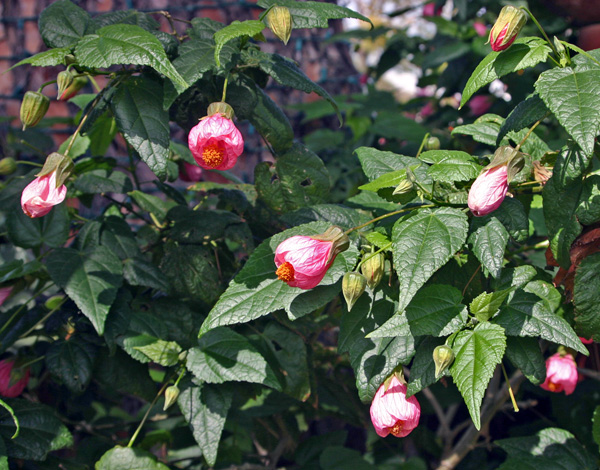 Flowering maples are easy to grow in containers and overwinter indoors. If given sufficient light, many will continue to bloom through the winter. They do best in a bright, sunny location, but prefer relatively cool temperatures (60’sF). Containers can be moved outdoors after the last frost, and should be moved back indoors before the first frost in the fall. Keep evenly moist during the growing season, but reduce watering indoors in the winter but avoid letting the plant dry out completely. Fertilize regularly starting in late winter when growth resumes, and stop in the fall. Some people recommend monthly fertilization, while others suggest every other week with half strength solution. Repot in the spring every year or two, using standard soilless potting medium. Moving to a larger pot will allow the plant to grow larger, so if space is limited just repot in the same size container.
Flowering maples are easy to grow in containers and overwinter indoors. If given sufficient light, many will continue to bloom through the winter. They do best in a bright, sunny location, but prefer relatively cool temperatures (60’sF). Containers can be moved outdoors after the last frost, and should be moved back indoors before the first frost in the fall. Keep evenly moist during the growing season, but reduce watering indoors in the winter but avoid letting the plant dry out completely. Fertilize regularly starting in late winter when growth resumes, and stop in the fall. Some people recommend monthly fertilization, while others suggest every other week with half strength solution. Repot in the spring every year or two, using standard soilless potting medium. Moving to a larger pot will allow the plant to grow larger, so if space is limited just repot in the same size container. 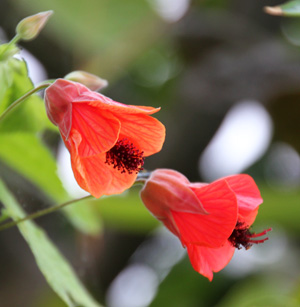 These plants have a tendency to become leggy and without regular pruning they can grow into a scraggly shrub. To maintain a dense, compact form they need to be pinched regularly. This will also promote more blooms as they only flower on new wood. Pinching, pruning and keeping a plant slightly root bound will help control its size. Major pruning should be done in early spring or late fall. Cut back branches selectively to shape the plant, making the cuts just above a node or on a strong, vigorous shoot near the plant’s base. Abutilon species can be grown from seed (it may take a full year before they begin blooming), but cultivars and hybrids are propagated by softwood cuttings taken at any time of the year. Bottom heat will speed rooting. Tip cuttings can be taken in late summer to overwinter instead of keeping the entire plant. Hundreds of varieties have been developed over the years. Some of the more commonly available abutilons include:
These plants have a tendency to become leggy and without regular pruning they can grow into a scraggly shrub. To maintain a dense, compact form they need to be pinched regularly. This will also promote more blooms as they only flower on new wood. Pinching, pruning and keeping a plant slightly root bound will help control its size. Major pruning should be done in early spring or late fall. Cut back branches selectively to shape the plant, making the cuts just above a node or on a strong, vigorous shoot near the plant’s base. Abutilon species can be grown from seed (it may take a full year before they begin blooming), but cultivars and hybrids are propagated by softwood cuttings taken at any time of the year. Bottom heat will speed rooting. Tip cuttings can be taken in late summer to overwinter instead of keeping the entire plant. Hundreds of varieties have been developed over the years. Some of the more commonly available abutilons include:
The abutilon, also known as flowering maple, is a beautiful blooming plant that can add incredible color and interest to gardens However, like all plants, abutilons are susceptible to various diseases that can threaten their health. Properly identifying and treating abutilon diseases is key to maintaining a vibrant, flourishing specimen.
In this comprehensive guide, we’ll cover the most common abutilon plant diseases how to diagnose them effective treatment methods, and prevention tips. Read on to gain the knowledge you need to keep your prized flowering maples happy and healthy.
Common Abutilon Diseases
There are several pathogens and environmental factors that can lead to diseases in abutilon plants
- Fungal diseases: Anthracnose, powdery mildew, leaf spot
- Bacterial diseases: Bacterial leaf spot
- Viral diseases: Abutilon mosaic virus
- Environmental factors: Root rot from overwatering, leaf scorch from low humidity
Understanding the specific disease plaguing your plant is crucial for proper treatment. Let’s look closer at symptoms, causes, and care for common abutilon problems.
Identifying Abutilon Diseases
Being able to accurately diagnose diseases in your abutilon is the first step toward effective treatment. Here are the most common symptoms to look for:
Anthracnose
- Irregular black or brown spots on leaves and stems
- Leaf loss
- Stem dieback
- Sunken lesions on fruits
Powdery mildew
- White powdery coating on leaves and stems
- Leaf curling and yellowing
- Stunted growth
Leaf spot
- Small brown spots on leaves
- Spots enlarge and turn black
- Severe leaf loss
Bacterial leaf spot
- Water-soaked spots on leaves
- Spots turn brown to black with yellow halos
- Leaves turn yellow and drop
Abutilon mosaic virus
- Yellow mottling and mosaic patterns on leaves
- Malformed leaves and stunted growth
- Plant decline
Root rot
- Leaf wilt and yellowing
- Stunted growth
- Roots appear brown and mushy
Leaf scorch
- Leaf browning and crisping at margins
- Leaf loss
Prompt disease identification allows you to take action before major plant damage occurs. If unsure, submit a sample to your local agricultural extension for diagnosis.
Treating Abutilon Diseases
Once you’ve identified the particular disease, you can move forward with effective treatment:
Fungal diseases
- Improve air circulation and reduce humidity
- Remove and destroy infected plant parts
- Apply fungicidal sprays as a preventative
- Treat soil with fungicides before replanting
Bacterial diseases
- Remove and destroy infected plant parts
- Apply copper-based bactericides
- Sterilize tools between plants
- Space plants properly for airflow
Viral diseases
- Remove and destroy infected plants
- Control insect vectors like aphids
- Isolate plants from virus sources
- Sterilize tools between plants
Environmental issues
- Adjust watering practices
- Increase air circulation
- Provide shade in intense sunlight
For fungal and bacterial diseases, be sure to remove and destroy all infected plant material to prevent further contamination. Severe infestations may require removal of the entire plant. Isolate diseased plants from healthy ones.
Preventing Abutilon Diseases
While even the best cared for abutilons can fall victim to diseases, there are some prevention methods to give your plants the best advantage:
- Select disease-resistant abutilon varieties
- Provide optimal growing conditions
- Avoid overhead watering
- Allow space between plants for airflow
- Sterilize tools between plants
- Remove spent flowers and dropped leaves
- Apply preventative fungicides/bactericides
- Control insect pests that can spread disease
With extra care and vigilance, you can help safeguard your abutilons from disastrous diseases. Routinely check for early symptoms and address problems promptly.
Abutilon Disease FAQs
Now that you know the basics of identifying and treating abutilon diseases, here are answers to some frequently asked questions:
What causes leaf spot disease?
Leaf spot is most often caused by a fungus like Cercospora or Alternaria. Spores infect the leaves through splashing water or insect damage.
How do you treat anthracnose?
Remove infected plant parts. Improving airflow and applying fungicides containing chlorothalonil, copper sulfate, or neem oil can help control anthracnose.
Is powdery mildew deadly to abutilons?
Powdery mildew can stunt growth and damage foliage but is rarely fatal alone. Combining cultural controls and fungicides provides the best control.
Should you cut back abutilons with disease?
Removing infected stems and leaves is recommended to prevent disease spread. Disinfect pruning tools between cuts. Avoid excessive pruning which can stress plants.
How do you fix an overwatered abutilon?
Allow the soil to dry out and provide less frequent watering. Trim off any mushy roots and repot in fresh, well-draining soil if needed.
Can you cure a diseased abutilon?
It depends on the severity of the disease and proper identification. Catching problems early allows the best chance of recovery with proper treatment.
Paying close attention to your abutilons and responding quickly at the first sign of disease is crucial. With knowledge of symptoms and diligent prevention methods, you can stay one step ahead of problems. Don’t allow diseases to claim the beauty of your flowering maples – take action at the first signs of trouble. Your efforts will be rewarded with vibrant blossoms and healthy foliage for years to come.

Featured Articles by Season




Ask Your Gardening Question
If you’re unable to find the information you need, please submit your gardening question here:
